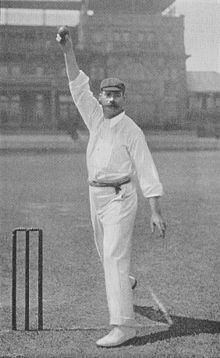Arthur Mold

Mold delivering the ball
|
||||||||||||||||||||||||||||||||||||||||
| Personal information | ||||||||||||||||||||||||||||||||||||||||
|---|---|---|---|---|---|---|---|---|---|---|---|---|---|---|---|---|---|---|---|---|---|---|---|---|---|---|---|---|---|---|---|---|---|---|---|---|---|---|---|---|
| Full name | Arthur Webb Mold | |||||||||||||||||||||||||||||||||||||||
| Born |
27 May 1863 Middleton Cheney, Northamptonshire, England |
|||||||||||||||||||||||||||||||||||||||
| Died | 29 April 1921 (aged 57) Middleton Cheney, Northamptonshire, England |
|||||||||||||||||||||||||||||||||||||||
| Batting style | Right-handed batsman | |||||||||||||||||||||||||||||||||||||||
| Bowling style | Right arm fast | |||||||||||||||||||||||||||||||||||||||
| International information | ||||||||||||||||||||||||||||||||||||||||
| National side | ||||||||||||||||||||||||||||||||||||||||
| Test debut (cap 84) | 17 July 1893 v Australia | |||||||||||||||||||||||||||||||||||||||
| Last Test | 26 August 1893 v Australia | |||||||||||||||||||||||||||||||||||||||
| Domestic team information | ||||||||||||||||||||||||||||||||||||||||
| Years | Team | |||||||||||||||||||||||||||||||||||||||
| 1889–1901 | Lancashire | |||||||||||||||||||||||||||||||||||||||
| Career statistics | ||||||||||||||||||||||||||||||||||||||||
|
||||||||||||||||||||||||||||||||||||||||
| Source: ESPNCricinfo, 25 September 2011 | ||||||||||||||||||||||||||||||||||||||||
Arthur Webb Mold (27 May 1863 – 29 April 1921) was an English professional cricketer who played first-class cricket for Lancashire as a fast bowler between 1889 and 1901. A Wisden Cricketer of the Year in 1892, he was selected for England in three Test matches in 1893. Mold was one of the most effective bowlers in England during the 1890s but his career was overshadowed by controversy over his bowling action. Although he took 1,673 wickets in first-class matches, many commentators viewed his achievements as tainted.
Mold began his professional cricket career playing for Banbury and Northamptonshire in the mid-1880s, but by 1889 had qualified to play for Lancashire at county level. Immediately successful, he quickly established a good bowling partnership with Johnny Briggs and became one of the leading bowlers in the country. However, he only achieved selection for England in one series in 1893. Many critics thought he threw rather than bowled the ball, and he was among several bowlers at the time about whom there were similar suspicions. Controversy erupted in 1900 when Mold was no-balled for throwing by Jim Phillips, an umpire who had targeted several prominent bowlers with dubious bowling actions. After Mold avoided several games in which Phillips was umpire, the affair came to a head in 1901. On the opening morning of a match, Phillips repeatedly no-balled Mold. Several of Mold's team-mates and most Lancashire supporters continued to believe that Mold bowled legally, but his reputation was ruined and, after three more appearances in 1901, he retired at the end of the season. After his departure from the game, throwing ceased to be a concern in English cricket for 50 years.
Mold was born on 27 May 1863 in the village of Middleton Cheney in Northamptonshire. His family had links with the thatching trade, but Mold pursued a career in professional cricket. He began to play for the village team, making good progress as a bowler; in 1882, Middleton Cheney were unbeaten and Mold had the best bowling average in the team. In 1885 and 1886, he was employed as a professional at Banbury Cricket Club. In his second year, a successful match against the Free Foresters, an amateur team, impressed two Lancashire cricketers who played against him. Subsequently in 1887, Mold was employed by Manchester Cricket Club, and played a few non-competitive cricket matches for Lancashire. In the same season, Northamptonshire, which at the time had not been awarded first-class status, asked Mold to play for them. Playing as a professional, Mold was immediately successful, taking ten wickets in a match against a team from Surrey and seven wickets for 22 runs (seven for 22) in an innings against Staffordshire. He continued to represent Northamptonshire in the following season but hoped to play for Lancashire. At the time, cricketers who wished to play competitive first-class matches for a county in which they were not born had to live there for two years to qualify.
...
Wikipedia
